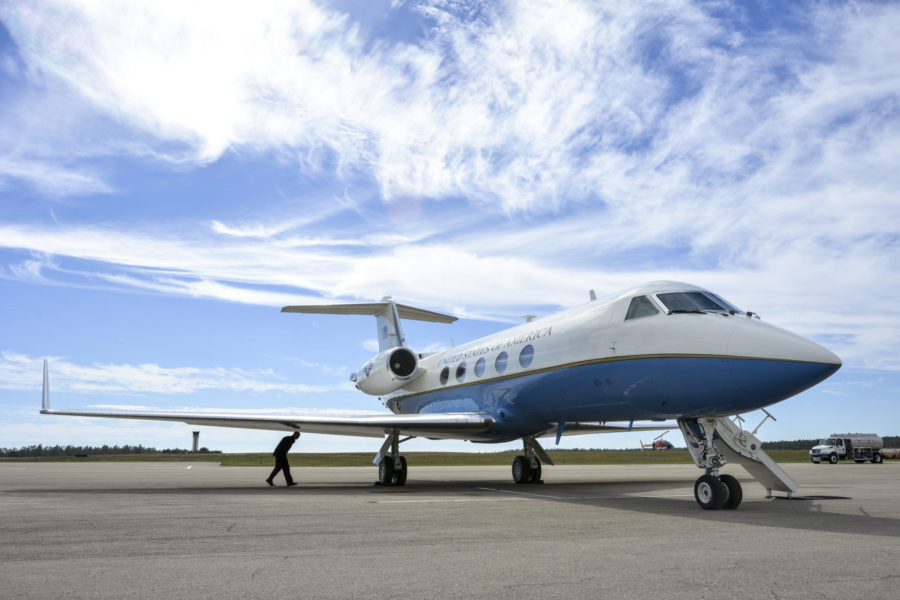Gulfstream has been a critical Department of Defense partner throughout its history. While Gulfstream first delivered its modified Gulfstream GII aircraft to the U.S. Navy in 1967, the company has been directly supporting the U.S. Air Force since 1983.
“Almost 40 years ago, we delivered the first C-20B Gulfstream GIII aircraft at the 89th Airlift Wing at Joint Base Andrews to support critical transportation for executive airlift command and control mission,” said Troy Miller, regional vice president for military and special mission sales at Gulfstream. “We’ve been providing Gulfstreams around the world ever since.”
Since then, Gulfstream has continued to provide aircraft, logistics, and maintenance support to securely transport senior political and military leaders.
“Recently, we have also expanded our support by modifying special missions’ aircraft, most notably our modified G550s to support the EC-37B Compass Call program,” Miller said. “We’re modifying those aircraft for the mission system’s prime contractors: L3Harris and BAE Systems. Together, we’re addressing the critical airborne electronic attack requirements that the Air Force has made clear it requires in the EC-37Bs that are slated to replace the current fleet of EC-130Hs.”
Gulfstream’s support of executive airlift command and control is vital to ensuring senior leaders stay connected when they travel.
“Over the years, we’ve improved the secure communications capabilities of our aircraft,” Miller said. “Our C-37As and C-37Bs are equipped with secure communication suites that enable our senior military and government leaders to conduct business securely during those long-range flights.”
Gulfstream’s experience in developing business jets prepared them to continually innovate to enhance their aircraft.
“As a leading business jet manufacturer worldwide, Gulfstream focuses first and foremost on safety,” Miller said. “But we also focus significantly on innovation by developing and implementing new capabilities and technologies into our aircraft to improve communications, navigation, and environmental conditions in the cabin.”
As an example, Miller offers the modifications made to secure communication capabilities for the senior leaders, including combatant commanders.
“Our aircraft provide reliable, safe, and productive air transportation over long ranges and high altitudes of operations at high speeds,” Miller said. “In response to increased demand for secure communications, we provide a work environment that senior leaders can conduct their critical business, particularly command and control missions, in-flight.”
In 1999, the General Dynamics Corporation purchased Gulfstream, enabling Gulfstream to innovate and expand its product lines to meet the demands of the future with aircraft like the new Gulfstream G700, which is currently undergoing flight testing.
“The G700 offers increased range, speed, and 56 percent more space in the cabin compared to the G550,” Miller said. “A larger cabin provides air transportation for more people and the ability to accommodate additional crew rest capability or galley capability for the special missions. We’re excited to have our newest aircraft address the Air Force’s emerging and evolving requirements.”
This addition is significant considering Gulfstream’s G550 continues to be one of the most prolific contributions the company has made to the Air Force, as evident by its recent incorporation into the C-37B fleet.
“With more than 600 G550s in service, that aircraft continues to be our most productive,” Miller said. “The C-37Bs are based on the G550 and recently, the Air Force has taken delivery of two additional C -37Bs. Without question, the G550 has been the workhorse that best represents Gulfstream addressing the needs of the Air Force to date.”
Gulfstream is a proud historical partner of the Air Force. Recently, two G550s delivered to Joint Base Andrews were selected to honor the Tuskegee Airmen and the Berlin Airlift, respectively, on their tails.
“Considering the Air Force’s emphasis on historical significance, it was humbling and a joy for our aircraft to receive a tail number that represents these historical events and figures,” Miller said.
It was a poignant reminder of the Air Force’s rich history, motivating Gulfstream to continue supporting the Air Force’s needs far into the future.
“Gulfstream’s next-generation aircraft family, including the G400, G500, G600 and G800, along with the G700, represent industry-leading capabilities and technology, and different segments of the performance spectrum in terms of ranges, sizes, and capabilities,” Miller said. “As we continue to develop new aircraft and modify our products, we will continue to support the executive airlift command and control needs and the special missions needs of the U.S. Air Force over the next 75 years.”
